A quick post on a current work-in-progress. It’s a 32 x 36″ oil, studio painting from a quarter-sized plein-air sketch.
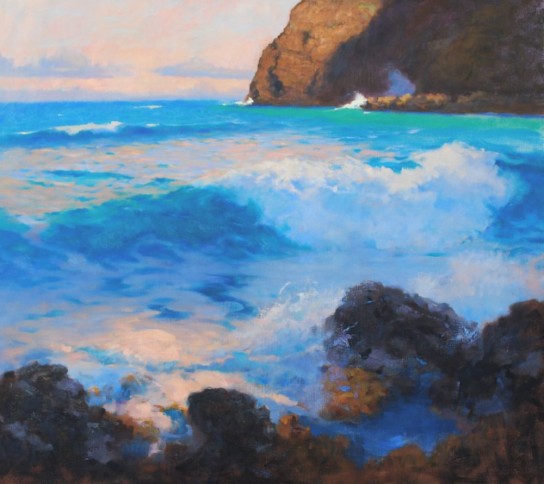
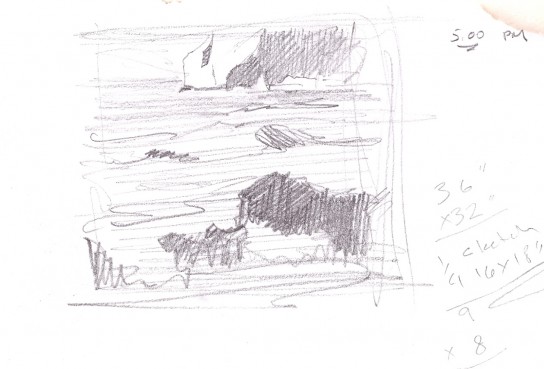 First sketchbook indication.
First sketchbook indication.
Current work
A quick post on a current work-in-progress. It’s a 32 x 36″ oil, studio painting from a quarter-sized plein-air sketch.

 First sketchbook indication.
First sketchbook indication.
This painting, Lanaika Point, is about finished as of today. I will let it sit for a few days and actually move on to other things, and have a fresh look at it on Friday or Saturday to se how it impacts me.
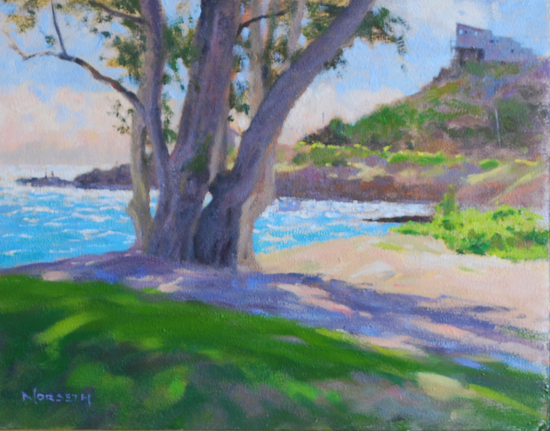
As I’ve mentioned, my goal, to capture the freshness and color of this place in a small painting (11 x 14″) is pretty much realized, I could only continue to add nuances that are, at this point, rather unlikely to enhance the effect.
I had proposed to add a figure for scale, but discarded the idea this morning.
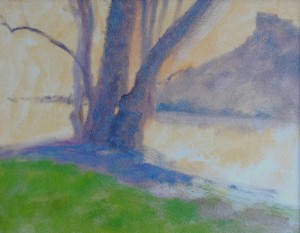
Here’s where I was with this painting a little over a week ago, the initial lay in. It’s fun to look back and see how things have developed. I have about six more such paintings in development for my show hanging at the end of this month.
Here’s another, a rather subdued tonal painting that I’m enjoying…I feel it may be too austere for some, but it has an appealing and emotional feel for me.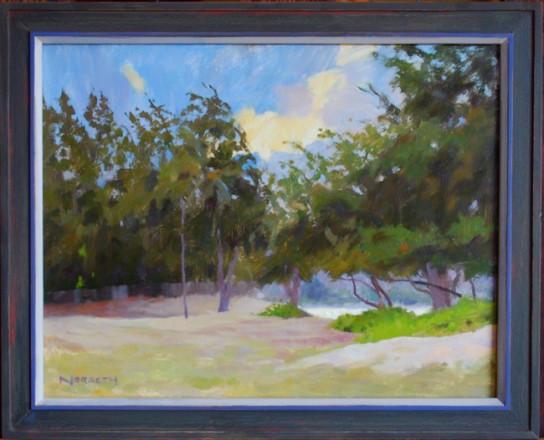
Dusk, Kailua 11 x 14″ oil on panel
A quick post…
this morning went quite well. Out the door by 7 AM, setup and running well before 8. The light was actually the only drawback, in that the sky was almost perfectly clear, and I realized that I’d have to adjust my values throughout. The darks were darker, essentially because I’d lost a bit of the atmosphere that a touch of cloud cover veils objects with.
No matter, I’ll get that effect again, since it’s one we commonly have, and having the deeper tones won’t be an obstacle. I’ll merely select the tones that work best when I tie the painting together towards the end.
Here’s a reminder of where I left off yesterday morning. The basic values and shapes are loosely established on a warm-toned panel ( 11 x 14″).

Today’s session (of about an hour and a half ) brought the values and colors closer to nature (closer to what the eye objectively sees), and I was able to work over the entire painting due to decent light conditions. As some clouds finally rolled in, the darks warmed a touch and lightened very slightly, which allowed me to get something closer to what I mentioned earlier, the effect I’m anticipating in the final work.
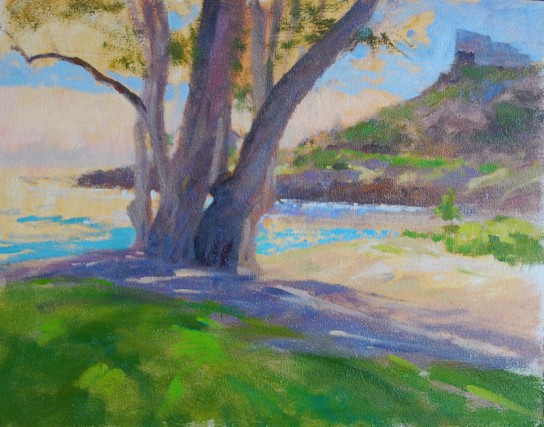
Working with a three-part medium, as I have most of the summer, and many good sized, pointed round bristle brushes on this, which leave a shape-mark that I like.
I’ve been noticing that I’m shying away from filberts recently for landscape…they seem somehow androgenous to me these days.
From here, I’ll take a day off and get back with this on Monday, weather and God permitting, to make it more More.
One change is that I’ll need to add a figure to make this work…the size of this grove of Ironwoods is deceptive, they are bigger trees than you might think from this little painting. It even surprises me a bit when a person goes by them, and this painting doesn’t yet reflect that contrast.
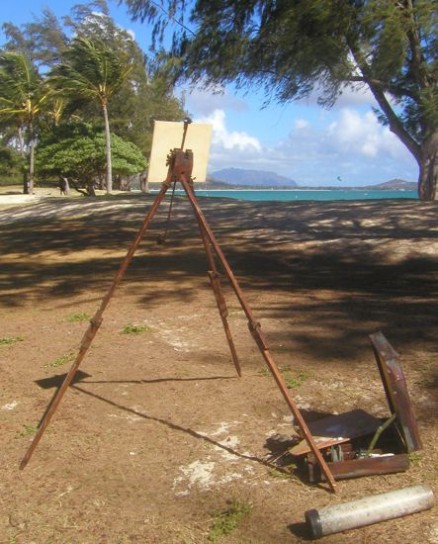
This is the setup I’m running with lately.
The vintage easel I picked up recently has become a great favorite of mine, mainly because I’ve seen it in photos of Willard Metcalf and others for years, and now feel I’m part of the club a bit, kind of like having the same brand guitar pick as Elvis or something. In some ways not as practical as a French easel or an Anderson style easel, I still love this baby. It takes all sizes of canvases, brass and steel fittings, and surveyor-tripod spiked tips.
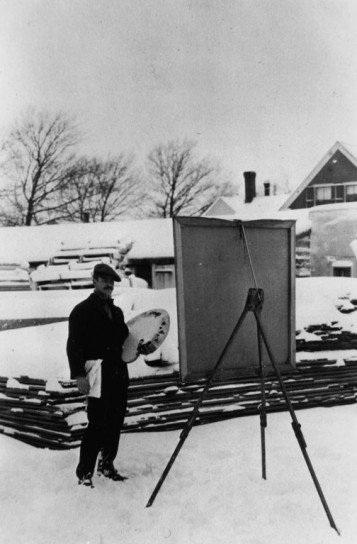
I found this photo of Edwin Dickinson working on the same easel in Provincetown. (Photo courtesy of the Provincetown Artist Registry)
And, Wilson Irvine somewhere with same:
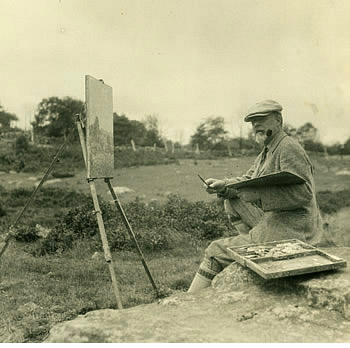
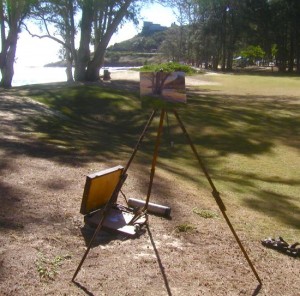
Haven’t posted recently…busy with show arrangements for “A Sideward Glance”, my next show at the Gallery at Ward Centre in October.
I’ve been working on some quiet, smaller paintings to go with a couple fairly involved pieces I’ve posted over the summer. They round things out nicely when (and if) successfully painted. I enjoy doing them very much, but I find myself somewhat in the minority amongst outdoor painters (I think it’s time to give “plein air” a little break) in that I have no reservations about working on them over as many sessions as necessary.
Anyway, when I get the gumption I’ll write out a cranky p.o.v. piece about the whole thing of outdoor painting devolving into something resembling a sporting event.
This morning, I returned to a location I worked from a couple of years back. I actually began the rough drawings a few days ago, and from those I felt I could attempt a small painting that explores the possibilities evoked by this place. I do this a lot, and think it’s actually a healthy sign. It’s not that the “scene” changes, but certainly the artist does, a fact that becomes evident to any painter who revisits a favorite painting in a museum after a long absence and sees it differently. The painting hasn’t changed, but it looks different. You find your emphasis and taste has evolved, or that you identify with the artist in a new way. It’s sort of the same thing with some locations.
Here’s the final of a half dozen little sketchbook drawings, followed by the inital lay-in of what I’ll be working on most mornings next week. I’ll try to remember to take a photo of the place and the painting setup I’m using these days.
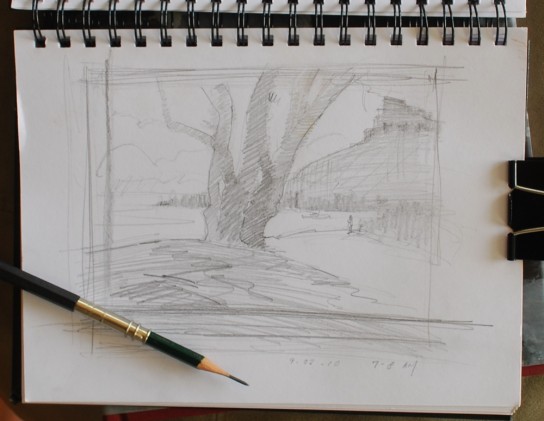
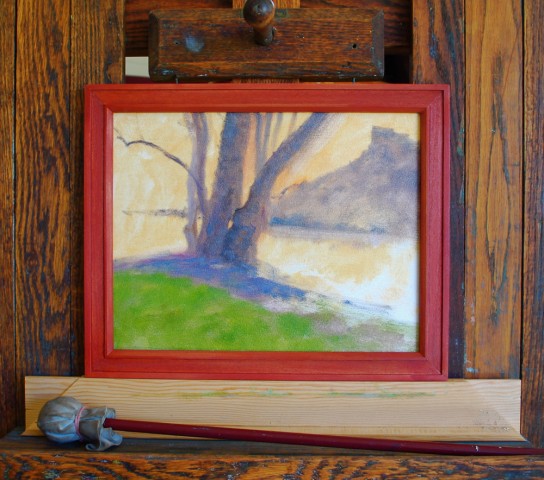
The painting, on a flake-white primed birch panel, is 11 x 14″, and I’ve tipped it into the frame that will be developed as I work on the painting. At least that’s the idea.
I could easily spend a week of mornings on this piece, in one hour snippets, depending on the weather and consistency of the light effect. Ten minutes from home, so not a big problem.
A secondary point of interest is that a big gathering of AA folks meet near where I’ll be working, and years ago I noticed what I considered a particularly strong attraction to my painting activities from some of them, which I welcome. I have a hunch that some seekers, perhaps in a cul-de-sac of addiction, see something special in the involvement of a painter and nature. The comments I’ve received from them has often seemed unusually respectful, almost reverent. Am I off base?
Developing the look of a glance rather than the prolonged stare will unlock the painting.
Continue reading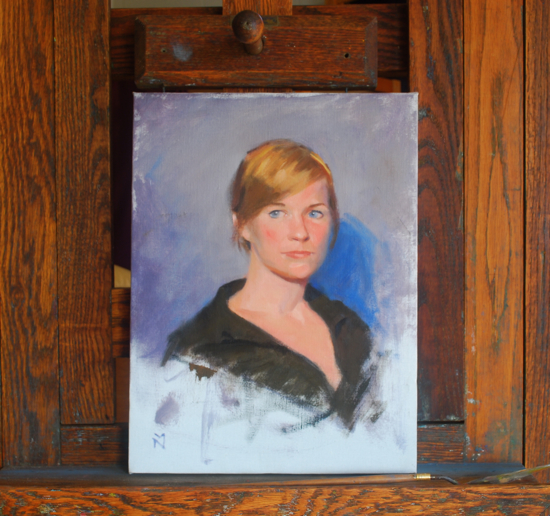
T.W. with Grey, 16 x 12″ oil on linen
Being involved with painting the outdoor world as much as I am, I really value the opportunity to teach classes involving the human form. When I teach, I always paint along with the class.
This is a portrait head completed over about 12 hours from a favorite model. Since we have students new to color, I often choose to have black and grey tones in the composition so that they can key their flesh color mixes against simple values.

The model looks good against grey, anyway.
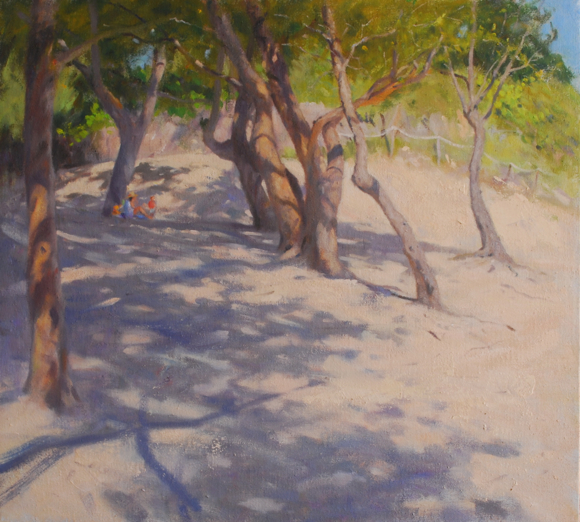 Silver -Grey, a Corner of Kailua Oil on Linen 20 x 22″
Silver -Grey, a Corner of Kailua Oil on Linen 20 x 22″
This piece is now finished, one painting of what has become a small series of paintings down in this wonderful area of my local beach. Construction of a frame is under way, and I’ll be varnishing in a couple months in time for a show in October.
It’s going in a direction I’d like to continue to pursue, turning away from the ocean-based works and drawing more on subjects that are a bit unexpected, the easily-overlooked glimpses of beauty. It’s been very helpful to find that others have responded well to this piece and other pictures like it. Despite popular notions of the artist forging a bold direction in spite of opinion, I find it gratifying to discover that I’m not alone in seeing that this difficult world has been laced with unexpected glimpses of heaven.
Because I’m beginning to find my way into creating prints of my work, I’ve decided that over the next year I’d create some paintings particularly suited to reproduction. On my list has been Halona Cove, a very special and very challenging location that I’ve painted repeatedly over the years.
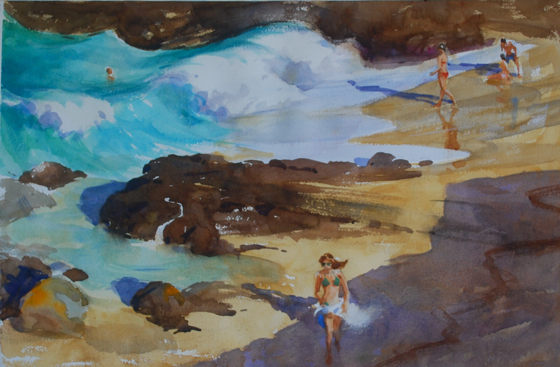 Halona Cove, final painting, watercolor, 15 x 22″
Halona Cove, final painting, watercolor, 15 x 22″
I brought this painting into existence using the smaller “plein-air” sketch shown below augmented by a number of pencil drawings, my preferred approach when painting directly, in situ, isn’t a practical solution.
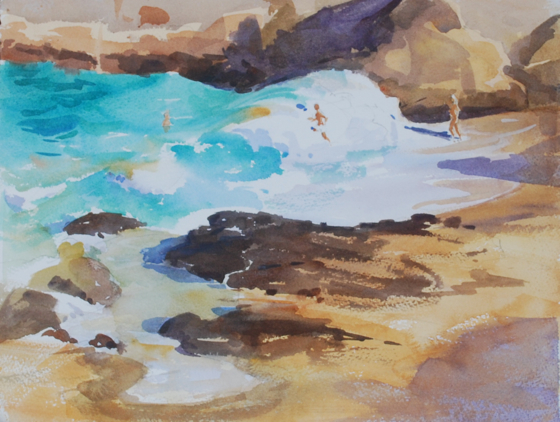 Halona Cove watercolor study, 11 x 14″
Halona Cove watercolor study, 11 x 14″
The watercolor study managed to grasp general colors and big shapes, some topographical information, and some figures for scale, but that’s about all I could glean from a watercolor excursion to this place, and the work falls short of my ambitions. However, I can use this as a guide in-studio, and when accompanied by pencil drawings and notes, I was able to create the larger and more complete painting that expresses more fully what I’d like to say.
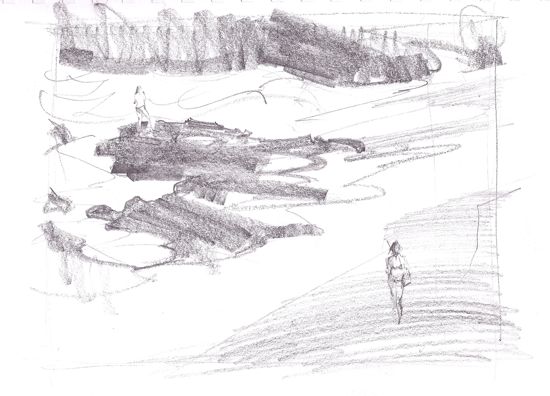 I find that compositional sketches, a simple breaking down of the basic elements into patterns, is indispensable.
I find that compositional sketches, a simple breaking down of the basic elements into patterns, is indispensable.
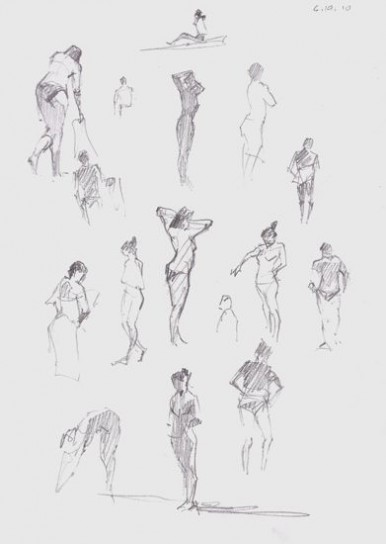
Because I’ve immersed myself in painting and drawing on location in Hawai’i, I’ve accumulated a large body of sketchbook material involving figures that I can use and manipulate as reference for paintings.
As my students know, I prefer this approach over the more popular method of using photography. Almost every painter I’ve come to admire worked without much reliance, if any, on the camera. I suspect that some of the shortcomings I find in contemporary representational art, as compared to the work of the older artist’s, is somehow tied to our reliance on the convenience of the camera over the impressions of the mind. At least I think that, and have been willing to challenge myself. Does anyone else think that bowing to convenience has seriously eroded our skills as observers? But more practically, the benefits of working this way are that I’m constantly strengthening my observational skills by drawing from life, am disciplined to create stronger mental impressions, and gain a deeper personal connection with what makes a place special. Perhaps such a practice will prove to have a positive accumulative effect over the years.
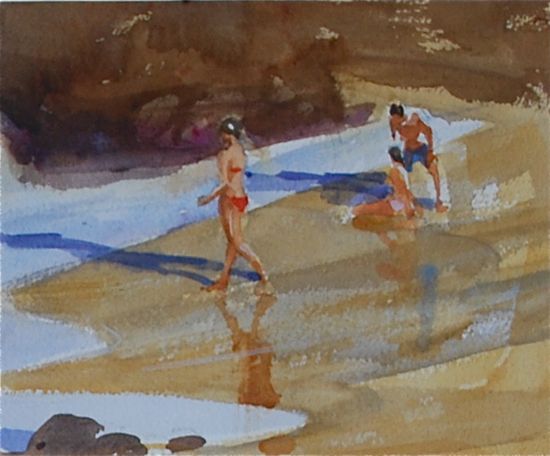
A detail of the background figures invented from rough sketchbook suggestions.
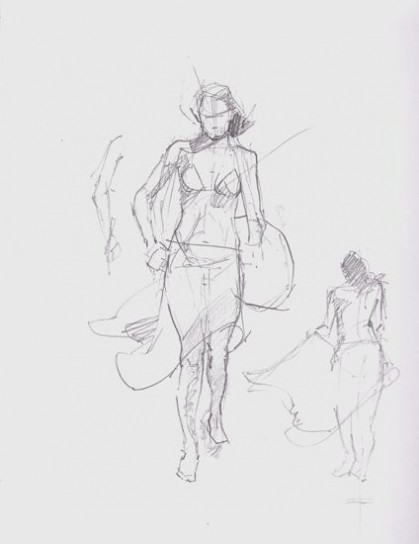
Working out the foreground figure